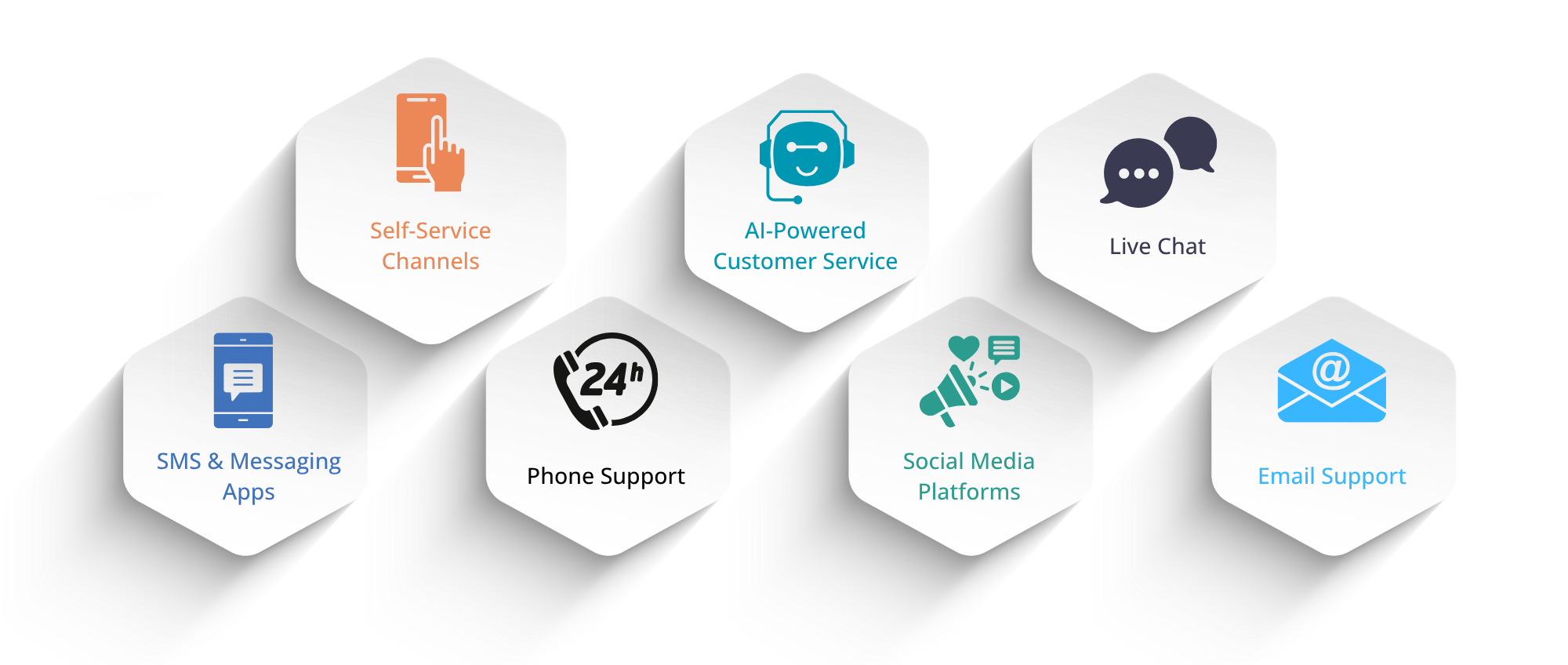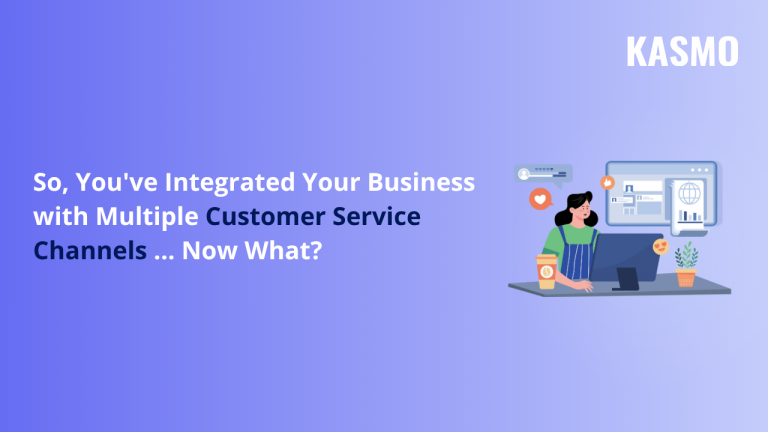What Role Do Customer Service Channels Play in Improving Customer Engagement?
Think about the last time you had to contact a business for support on any issue you were facing. How easy was it to get help? How long did you wait? If your answer is – “I had to wait for hours”, that means the company is not doing their customer service right. With almost 77% of customers expecting to immediately get in touch with a customer service representative as soon as they contact a business, they cannot afford to make their customers wait and lose them. Now, with multiple customer service channels at their disposal, attending to customers has become easy.
However, maintaining the same level of dedication and quality across all these customer service channels is not easy. As more and more customers are expecting fast, convenient, and personalized services, businesses need to understand how they can leverage multiple communication channels effectively.
Maintaining a brand presence on the customer service channels is not enough. Businesses need to understand the language of customers, which means they need to understand how and where the customers want the businesses to meet their needs and requirements. They’re busy, they’re constantly moving, and they want to engage on their terms, whether that’s via live chat during a work break, email after working hours, or through social media channels while commuting.
That’s why businesses’ multichannel contact centers need to be active even after the closing hours. By maintaining a constant presence, you can establish better customer relationships and enhance customer engagement.
But there’s a big challenge in staying operational 24/7. Your employees will burn out quickly and their productivity will decrease. For this, you need an agent that can work 24/7 without breaks and without falling ill. Salesforce Agentforce’s AI Agents are designed for just that. When constant communication is crucial, businesses can deploy these AI Agents and achieve just that. You can customize AI Agents and empower your customer service teams to work faster and better.
AI Agents are not meant to act as a replacement for your human workforce – they are merely a tool to empower your employees to give the best customer service and help you enhance customer loyalty. By combining both human agents and AI, you can be available when and where your customers are. The more you integrate AI Agents with your different customer service channels; you’ll get more opportunities to connect with your customers. With an increased number of interactions, you’ll increase the chances of enhancing customer loyalty, driving satisfaction, and creating long-term value for your business.
Customer service channels, when integrated into a unified platform like Salesforce, help you get a better understanding of your operations and customer interactions. With all customer interactions, history, and operational data in one place, your customer support teams can deliver faster resolutions and more personalized experiences, without switching between these channels multiple times.
This is where Salesforce Service Cloud and Agentforce come in. By centralizing all your customer support efforts, you can decrease operational costs, improve agent productivity, and engage customers more effectively across their preferred touchpoints. Better engagement leads to better business outcomes. It increases trust, reduces customer churn, and creates loyal customers.
Types of Customer Service Channels Businesses Can Leverage to Enhance Customer Experience
Customers expect more than just faster product or service delivery. They demand seamless and personalized support at every touchpoint. To meet these growing expectations, businesses must provide service through different types of customer service channels:

Self-Service Channels
Self-service has become one of the most powerful customer service tools. Customers value autonomy and 61% prefer using self-service channels for simple issues. A well-designed self-service channel can resolve an estimated 54% of customer issues on average, freeing up customer service teams to handle more complex queries.
Want to give more autonomy to your customers and make them feel more included? Here’s what you need to provide them:
- Knowledge Base: A centralized hub where customers can find answers to common questions, how-to guides, troubleshooting tips, and FAQs. Regularly updating this content based on customer queries helps ensure it remains relevant.
- Customer Portals: Personalized portals that allow customers to track orders, manage their accounts, view past purchases, and even initiate processes like returns or service requests. These portals can be integrated with AI to provide 24/7 assistance through virtual agents.
- AI Chatbots: AI-powered chatbots can offer instant answers to simple inquiries or direct customers to relevant resources. Tools like Salesforce’s Agentforce provide autonomous AI agents that get smarter over time by learning from customer interactions.
AI-Powered Customer Service
Artificial Intelligence is revolutionizing customer service, allowing businesses to provide continuous support while reducing operational costs. AI-powered agents, like Salesforce’s Agentforce, use Natural Language Processing (NLP) to understand the context and intent behind customer queries. These intelligent bots can handle simple inquiries, escalate issues when necessary, and even perform tasks like scheduling appointments or issuing refunds.
Key Benefits of AI Agents:
- 24/7 Availability: AI agents can operate around the clock, providing customers with support regardless of time zone or business hours.
- Contextual Understanding: Unlike traditional chatbots, AI agents can understand the nuances of customer queries, offering more natural and effective responses.
- Reduced Workload for Human Agents: By automating repetitive tasks, AI agents allow human employees to focus on high-priority or complex issues.
Live Chat
Live chat is one of the most effective ways to offer quick, real-time resolutions to customer inquiries. It combines the benefits of phone support with the convenience of text-based communication. A Salesforce study reveals that nearly 90% of high-performing service organizations offer live chat, which is a significant improvement over under-performing organization.
Why Live Chat Works:
- Instant Communication: Customers can get real-time help without the need to make a phone call. This is especially useful for answering quick questions or resolving issues like online shopping.
- Efficiency: Agents can handle multiple chat conversations at once, reducing wait times and allowing for faster resolutions compared to phone support.
- Cost-Effective: Since agents can manage several chats at once, it is a cost-efficient way to scale customer service operations.
SMS & Messaging Apps
SMS and messaging apps allow businesses to communicate with customers in a way that feels personal and immediate. The convenience of text-based communication offers customers a quick and hassle-free alternative to traditional support channels.
Since customers and businesses alike rely heavily on smartphones, SMS and messaging apps like WhatsApp have become one of the most vital customer service channels. These platforms provide a more casual, personal way for customers to interact with brands.
If you are looking to take a more friendly approach while solving customer challenges, SMS and messaging platforms will be your best choice.
- High Open Rates: Text messages have significantly higher open rates than emails, making them an effective way to ensure your message is seen quickly.
- Convenience: Customers don’t need to be on a computer to get support—they can send and receive messages on the go.
- Rich Media Support: Many messaging apps allow businesses to send multimedia content (like photos, videos, or links), making it easier to troubleshoot or demonstrate solutions.
Phone Support
Phone support remains a top choice for customers dealing with more complex issues. Even though other customer service channels are rising in popularity, phone calls continue to provide a level of personal touch that other channels may sometimes lack.
 Social Media Platforms
Social Media Platforms
Social media channels have evolved into a primary touchpoint for customer service. Platforms like Twitter, Facebook, and Instagram allow businesses to engage directly with customers in a public, informal manner. These platforms allow businesses to provide a hyper-personalized approach to customer issues in a public forum. Quick, visible responses help boost brand perception. With the power of social media, customers can easily reach out to businesses in a shorter amount of time. As businesses are focusing more on their brand image and reputation, customers get a faster reply on social media, which enhances customer engagement.
This type of customer service channel requires very little effort from the customers’ end to get in touch with any business. It also makes it easy for businesses to address customer queries or concerns.
Email Support
Providing customer service through emails is one of the oldest ways businesses have provided support to their customers. This form of support is effective for customers who are facing complex issues, and they need time to review responses and solutions at their own pace. Customers can reach out at any time and respond when convenient for them. This flexibility is especially useful for non-urgent inquiries.
Agents can craft well-thought-out replies, complete with attachments or links to resources, that can help customers with their issues through this communication channel. It also records all communications, which is helpful for both the customer and support teams for future reference.
Providing customer service through emails allows businesses to provide a methodical, detailed way to resolve customer issues while ensuring there is a written record of the conversation. This makes it a reliable choice for addressing intricate matters that require clear communication.
Redefining Customer Experience and Enabling Seamless Service Delivery for Bhanzu
How Salesforce Helps Businesses Improve Customer Experience
Salesforce enhances customer experience by unifying and optimizing various customer service channels on a single platform. With Salesforce Service Cloud, businesses can manage interactions via phone, live chat, email, SMS, social media, and self-service portals in one place. This ensures seamless, personalized support across all touchpoints.
Salesforce Agentforce enables businesses to provide 24/7, context-based assistance in natural language to customers. These AI Agents can be tailored to handle simple queries and automate repetitive and manual tasks. These agents can also smoothly escalate complex issues to human agents. Salesforce also empowers customers with self-service options through knowledge bases and customer portals, allowing them to solve common problems independently, enhancing customer engagement.
By integrating social media and messaging apps, Salesforce enables businesses to offer real-time responses and personalized services. With Computer Telephony Integration (CTI), businesses can audit and improve their customer support through phones and maintain the same standard of customer service irrespective of communication channels.
With Salesforce, businesses deliver fast, consistent, and personalized support, empowering teams with tools to improve service quality and enhance customer satisfaction. Whether it’s AI-driven support or seamless multi-channel interactions, Salesforce helps businesses provide the best possible experience at every touchpoint.
Conclusion
By leveraging a mix of modern customer service channels like self-service, AI-driven agents, live chat, social media channels, and phone support, businesses can meet customers where they are, delivering timely, personalized, and seamless support.
Salesforce plays a pivotal role in this process, providing a unified platform that integrates all these channels, streamlining operations, and enabling businesses to offer an enhanced customer experience. With tools like Service Cloud and Agentforce, Salesforce empowers companies to proactively address customer needs, reduce dissatisfaction, and improve service efficiency.
The key to achieving the best customer service success lies in a business’s ability to connect with customers on multiple channels, using data-driven insights to anticipate needs and deliver value. With the right tools and strategies in place, customer service becomes a powerful way to build lasting relationships and drive business growth. By embracing the power of Salesforce and Kasmo’s expertise, organizations can deliver exceptional customer experiences.




